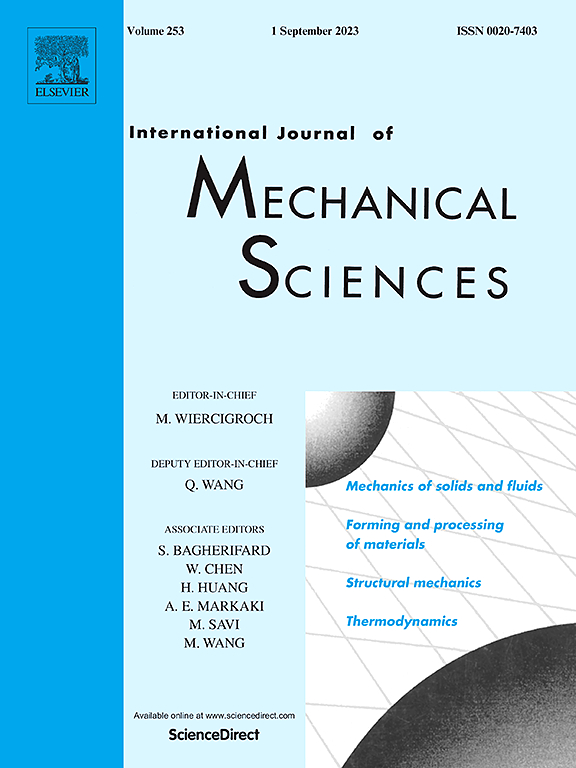Numerical prediction of vortex-induced vibrations of a long flexible cylinder with variable cross-sections
IF 7.1
1区 工程技术
Q1 ENGINEERING, MECHANICAL
International Journal of Mechanical Sciences
Pub Date : 2025-03-20
DOI:10.1016/j.ijmecsci.2025.110176
引用次数: 0
Abstract
Long flexible cylinders with variable cross-sections are extensively used in engineering applications, yet their vortex-induced vibration (VIV) behavior under linear shear flow remains insufficiently investigated. This study proposes a novel semi-analytical method that integrates the Sturm-Liouville Eigenvalues using Theta Matrices (SLEUTH method) with the Generalized Integral Transform Technique (GITT), enabling efficient and highly accurate VIV predictions. This approach addresses the computational challenges of traditional numerical methods while accurately capturing key structural responses including the structural displacement, structural frequency, displacement envelope, and displacement evolution. Validation against existing experimental data and finite element simulations confirm the method's superior accuracy and computational efficiency. Results reveal that variations in cross-section significantly influence VIV behavior. Tapered, waist-shaped, and stepped cylinders exhibit distinct displacement distributions and frequency responses under shear flow conditions. Tapered cylinders experience amplified displacements in regions with increasing flow velocity, waist-shaped cylinders exhibit localized vibration attenuation, and stepped cylinders display abrupt transitions in displacement envelopes at geometric discontinuities. These findings lay a robust theoretical framework for analyzing VIV in variable cross-section structures, providing essential design guidance for mitigating flow-induced vibrations in offshore and marine engineering applications.

变截面柔性长圆柱涡激振动的数值预测
变截面柔性长圆柱体在工程中得到了广泛的应用,但其在线性剪切流作用下的涡激振动特性研究尚不充分。本研究提出了一种新的半解析方法,将Sturm-Liouville特征值利用Theta矩阵(SLEUTH方法)与广义积分变换技术(git)相结合,实现了高效、高精度的VIV预测。该方法解决了传统数值方法的计算挑战,同时准确捕获了关键的结构响应,包括结构位移、结构频率、位移包络线和位移演化。通过对已有实验数据和有限元仿真的验证,证实了该方法具有较高的精度和计算效率。结果表明,截面的变化显著影响VIV行为。锥形、腰形和阶梯圆柱体在剪切流动条件下表现出明显的位移分布和频率响应。锥形圆柱体在流速增加的区域位移放大,腰形圆柱体表现出局部振动衰减,阶梯式圆柱体在几何不连续处表现出位移包络的突变。这些发现为分析变截面结构的涡激振动奠定了坚实的理论框架,为减轻海上和海洋工程应用中的流致振动提供了重要的设计指导。
本文章由计算机程序翻译,如有差异,请以英文原文为准。
求助全文
约1分钟内获得全文
求助全文
来源期刊

International Journal of Mechanical Sciences
工程技术-工程:机械
CiteScore
12.80
自引率
17.80%
发文量
769
审稿时长
19 days
期刊介绍:
The International Journal of Mechanical Sciences (IJMS) serves as a global platform for the publication and dissemination of original research that contributes to a deeper scientific understanding of the fundamental disciplines within mechanical, civil, and material engineering.
The primary focus of IJMS is to showcase innovative and ground-breaking work that utilizes analytical and computational modeling techniques, such as Finite Element Method (FEM), Boundary Element Method (BEM), and mesh-free methods, among others. These modeling methods are applied to diverse fields including rigid-body mechanics (e.g., dynamics, vibration, stability), structural mechanics, metal forming, advanced materials (e.g., metals, composites, cellular, smart) behavior and applications, impact mechanics, strain localization, and other nonlinear effects (e.g., large deflections, plasticity, fracture).
Additionally, IJMS covers the realms of fluid mechanics (both external and internal flows), tribology, thermodynamics, and materials processing. These subjects collectively form the core of the journal's content.
In summary, IJMS provides a prestigious platform for researchers to present their original contributions, shedding light on analytical and computational modeling methods in various areas of mechanical engineering, as well as exploring the behavior and application of advanced materials, fluid mechanics, thermodynamics, and materials processing.
 求助内容:
求助内容: 应助结果提醒方式:
应助结果提醒方式:


